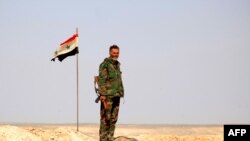There are two pieces to Lavrov’s claim which need examination -- that Damascus was only a few weeks away from falling when Russia intervened in Syria at the end of September 2015, and that terrorists would have seized Syria’s capital city had Russia not intervened.
In May 2015, CBS News reported that recent Syrian Military defeats in Idlib Province, in Syria’s northwest, could signal that the regime was weakening severely, the result of years of war. In July 2015, The Guardian’s Luke Harding warned that a supply crisis in the Syrian military had the regime “on the brink of collapse,” according to defectors from the Syrian military. That article described military defeats, sinking moral, ambushed supply routes, and advancing Syrian rebels. Harding quoted General Robert Mood, the former head of the UN monitoring mission in Syria, as saying:
"In my opinion it is only a matter of time before a regime that is using such heavy military power and disproportional violence against the civilian population is going to fall.
"Every time there are 15 people killed in a village, 500 additional sympathizers are mobilized, roughly 100 of whom are fighters."
None of those articles, however, cite rebel advances near Damascus. The maps created by Syria.Liveuamap.com do not show any particularly heavy fighting near Damascus at that time. While few analysts at the time would disagree with the thesis that the Syrian rebels were advancing and the Syrian military was in disarray, the rumors of the Syrian government’s imminent demise were clearly overly ambitious.
What was happening, however, was a collapse of Syrian military positions in Idlib Province and the advance of Western-backed rebel groups into Latakia, long considered to be the last “stronghold” of the Syrian regime. In fact, a report published in late September by The Washington Institute for New East Policy, just as the Russians were beginning their deployment to Syria, suggested that Latakia could be the “achilles heel” of the Assad regime, and its loss could ultimately lead to the fall of the government. That report begins:
“Over the past few months, the Syrian army has grown weaker and lost many positions, a development that explains Russia's recent deployment of troops. Previously, Russia had sent only military advisors and technical staff to support the Syrian army. Another key question, however, involves why these troops are being sent to Latakia and not Tartus, site of the official Russian military base. Indeed, this new, strong Russian presence along the northern Syrian coast can be explained by the Assad regime's weakness in the area, where Alawites no longer constitute a majority.”
As such, we have to conclude that while the Assad regime collapsing in northwestern Syria, and defeat of the Syrian military was becoming a real possibility by the end of the summer of 2015, Lavrov was likely exaggerating when he said that the loss of Damascus was only two to three weeks away.
Lavrov’s second claim -- that terrorists were the ones who were about to capture Damascus -- relies entirely on Russia’s definition of “terrorist.” Russia’s first air strikes in Syria were not against the extremist group Islamic State (IS), nor did they target Al-Qaeda-linked groups like Jabhat al-Nusra. Rather they hit moderate rebel groups, including those which had received weapons from the United States. Generally speaking, Russia has not focused on attacking either IS or Al-Qaeda in Syria.
"We are convinced that we acted correctly when we responded positively to the request of the lawful government of Syria, a UN member state, a country whose capital was two to three weeks away from being seized by the terrorists.”
Unclear
...no verifiable proof Damascus was on verge of collapse.
